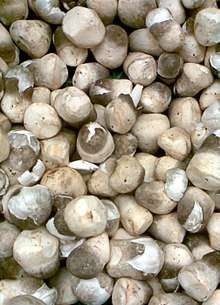Volvariella volvacea
Volvariella volvacea (also known as paddy straw mushroom or straw mushroom) is a species of edible mushroom cultivated throughout East and Southeast Asia and used extensively in Asian cuisines. They are often available fresh in Asia, but are more frequently found in canned or dried forms outside their nations of cultivation. Worldwide, straw mushrooms rank third in consumption, although their use in the West is somewhat uncommon and usually confined to use in Oriental cooking. [2]
| Paddy straw mushrooms | |
|---|---|
 | |
| Straw mushrooms, with some still in their veils, while others have opened and reveal the cap inside | |
| Scientific classification | |
| Kingdom: | |
| Division: | |
| Class: | |
| Order: | |
| Family: | |
| Genus: | |
| Species: | V. volvacea |
| Binomial name | |
| Volvariella volvacea | |
| Synonyms | |
| Volvariella volvacea | |
|---|---|
float | |
| gills on hymenium | |
| cap is conical or umbonate | |
| hymenium is free | |
| stipe has a volva | |
| spore print is salmon | |
| ecology is saprotrophic | |
| edibility: choice | |
Cultivation
Straw mushrooms are grown on rice straw beds and are most commonly picked when immature (often labeled "unpeeled"), during their button or egg phase and before the veil ruptures.[3] They are adaptable and take four to five days to mature, and are most successfully grown in subtropical climates with high annual rainfall. No record has been found of their cultivation before the 19th century.[4]
Nutrition
One cup of straw mushrooms is nutritionally dense and contains 58 calories, selenium, Se 27.7 µg (50.36%), sodium, Na 699 mg (46.60%), iron, Fe 2.6 mg (32.50%), copper, Cu 0.242 mg (26.89%), vitamin B9 (Folate) 69 µg (17.25%), phosphorus, P 111 mg (15.86%), vitamin B5 (pantothenic acid) 0.75 mg (15.00%), protein 6.97 g (13.94%), total dietary fiber 4.5 g (11.84%), and zinc, Zn 1.22 mg (11.09%).[5][6]
Identification
In their button stage, straw mushrooms resemble poisonous death caps, but can be distinguished by several mycological features, including their pink spore print (spore prints of death caps are white). The two mushrooms have different distributions, with the death cap generally not found where the straw mushroom grows natively, but immigrants, particularly those from Southeast Asia to California and Australia, have been poisoned due to misidentification.[7][8]
References
- "Species Fungorum - GSD Species". www.speciesfungorum.org.
- "Straw Mushrooms".
- Chang, S. T.; Chang, Shu-ting; Quimio, T. H. (9 January 1982). "Tropical Mushrooms: Biological Nature and Cultivation Methods". Chinese University Press – via Google Books.
- Hsiung, Deh-Ta (2006). The Chinese Kitchen. London: Kyle Cathie Ltd. pp. 186–87. ISBN 1-85626-702-4.
- "Straw Mushroom facts and health benefits". Health Benefits Times. 2019-05-30. Retrieved 2019-11-05.
- "Cultivation, nutrition, biochemicals and enzyme analysis of paddy straw mushroom (Volvariella volvacea)". International Journal of Current Research. Retrieved 2019-11-05.
- Money NP. (2004). Mr. Bloomfield's Orchard: The Mysterious World of Mushrooms, Molds, and Mycologists. Oxford University Press. p. 153. ISBN 978-0-19-517158-7.
- Gardiner, Stephanie (3 January 2012). "Two die after eating death cap mushrooms". The Sydney Morning Herald.
External links
| Wikisource has original text related to this article: |
- Straw Mushroom
- http://www.indexfungorum.org/Names/SynSpecies.asp?RecordID=307802
- http://www.indexfungorum.org/Names/NamesRecord.asp?RecordID=307802
| Wikimedia Commons has media related to Volvariella volvacea. |